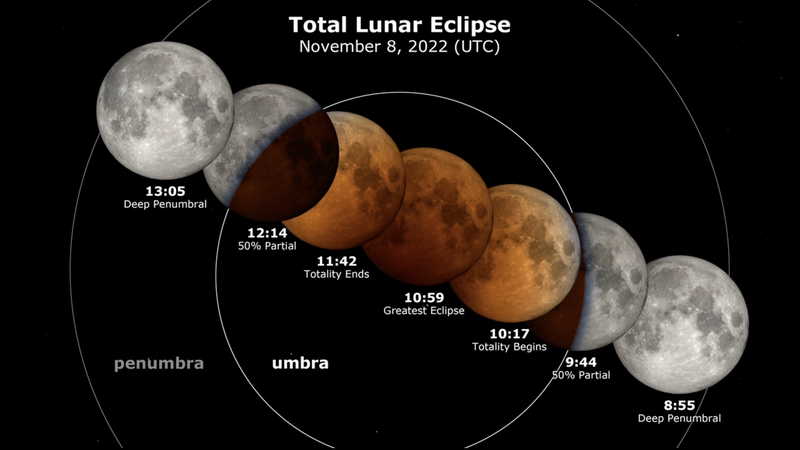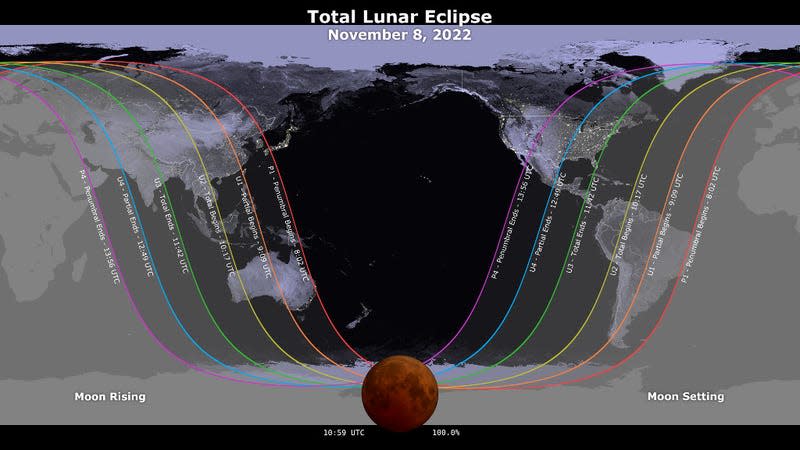How to See Tomorrow Morning's Total Lunar Eclipse

Lunar eclipses may be more common that solar eclipses, but they’re still incredible sights to behold. On Tuesday, some parts of the world will get an early morning view of a total lunar eclipse, in which the full Moon will steadily darken and appear to turn red under Earth’s shadow.
How can I watch the total lunar eclipse?
This week’s lunar eclipse will occur the morning of Tuesday, November 8, marking the first total lunar eclipse in three years and the last until March 14, 2025, according to NASA. This eclipse should be visible to the naked eye, but telescopes and binoculars can help enhance our view from Earth.
Read more

The totality of the eclipse—when the Moon is entirely within Earth’s shadow—will be visible from North and Central America as well as Ecuador, Colombia, and western portions of Venezuela and Peru. NASA says that the totality will begin at 10:17 UTC (5:17 a.m. ET) and end at 11:42 UTC (6:42 a.m. ET), with the greatest eclipse happening at 10:59 UTC, or 5:59 a.m. ET. The eclipse will also be visible in other parts of the world, though most of the peak activity will be occurring during the evening when the Moon may not be fully visible yet.
If you’re on the U.S. East Coast, then you’ll be able to see the eclipse starting at 3:02 a.m. local time as the Moon enters the outer part of Earth’s shadow, called the penumbra, until moonset occurs between approximately 6:00 a.m. and 6:40 a.m.
For those in Central Time, the eclipse begins at 2:02 a.m. and will last until moonset occurs between approximately 6:00 a.m. and 6:40 a.m.
In Mountain Time, the eclipse begins at 1:02 a.m. and will last until 6:50 a.m., slightly abridged by moonset.
If you’re on the West Coast, your view of the eclipse won’t be cut off by moonset. It will begin at 12:02 a.m. and will last until 5:50 a.m.
If you’re not in the optimal viewing area, or it’s cloudy, or you simply don’t feel like waking up so early or staying up so late to see the Moon turn red, there will be live streams available from different sources to view the eclipse in all its beauty. TimeAndDate, Lowell Observatory in Arizona, and Springfield Science Museum in Massachusetts will all be hosting live streams.
Total Lunar Eclipse Live Stream from the Observatory at the Springfield Science Museum
What is a lunar eclipse?
A lunar eclipse occurs when the Sun, Earth, and Moon are aligned in such a way that Earth blocks incoming light from the Sun, casting a shadow on the Moon—when the Moon is completely enveloped in the Earth’s shadow, this is a total lunar eclipse. This stands in opposition to a solar eclipse, when the Moon is blocking out the Sun as seen from Earth. Unlike solar eclipses, lunar eclipses are completely safe to look at with the naked eye.
Lunar eclipses can appear red due to a phenomenon known as Rayleigh scattering, where Earth’s atmosphere scatters the shorter wavelengths of blue light. Usually when we see the Moon shining, we’re seeing sunlight that has directly hit it and is reflecting back at us. But during an eclipse, that sunlight filters through Earth’s atmosphere before striking the Moon. Longer wavelength red light passes more easily through the atmosphere—as seen in the orange hues or sunrises and sunsets—making the Moon appear to be bathed in reddish light.
More from Gizmodo
The Best Shortcuts On Mac: Snap Windows, Text to Speech, and More
How to Delete Your Twitter Account If Elon Musk Was Your Last Straw
Sign up for Gizmodo's Newsletter. For the latest news, Facebook, Twitter and Instagram.

